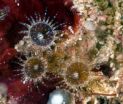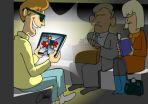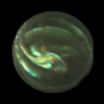(Press-News.org) The wing of a fruit fly may hold the key to unraveling the genetic and molecular events that transform a normal cell into a cancerous one. The study, conducted on Drosophila melanogaster by scientists at the Institute for Research in Biomedicine (IRB Barcelona) and led by ICREA researcher Marco Milán, has reproduced each of the steps known to take place when a healthy cell turns cancerous. The researchers have thus provided an inexpensive and effective model that will allow the scientific community to scrutinize the genes and molecules involved in each step. Given that the vast majority of genes in Drosophila are conserved in mice and humans, the results obtained may also lead researchers to perform similar studies in more clinically relevant models. Proceedings of the National Academy of Sciences USA (PNAS) has published the study online this week.
Argentinian scientist Andrés Dekanty, a Juan de la Cierva researcher in the Milán lab and first author of the article, explains that "for the first time we have a genetic model that allows us to understand the events that take place, starting from when cells begin to accumulate genomic errors until the development of a tumour." The Milán team began by provoking genomic instability in a selection of cells in the fly wing. They then prevented these cells, with an aberrant number of chromosomes (aneuploidy), from succumbing to the cells' natural defense mechanisms so that they would survive. From there, they observed that the cells spread throughout the tissue, became mobile, activated the growth of adjacent cells, and degraded the basal membrane that kept them in place, allowing them to break free and even invade nearby tissues. "All of these events are things that we see in cancer. This fly model will therefore help us to identify each of the genes and molecules involved in epithelial cell detachment (delamination), motility, abnormal growth, basal cell degradation and invasion," says Milán.
"This study takes things one step beyond, however," say the researchers, "and opens a fundamental conceptual debate." This is the first time that these phenomena have been described in relation to genomic instability. "This has allowed us to propose something that hasn't yet been possible to study in depth and that now should be taken into serious consideration. Is genomic instability the cause of tumorigenesis?" says Milán.
Genomic instability, a cause of cancer?
Cells in all human cancers display considerable genomic instability. Their genomes are full of mistakes. "If we can demonstrate this direct correlation, we will have something very specific to work with to find precise targets. Aneuploid cells don't exist in healthy organisms. If we can identify what differentiates a cell with genomic instability from a normal cell, we may be able to identify specific treatments," says Dekanty.
Today, cancer therapies are aimed at slowing proliferation, or cell division. A major problem with this is that all cells – both cancerous and healthy ones – divide. Treatments are therefore associated with many side effects. "There isn't a treatment available that attacks only the cells with genomic instability," say the researchers. "If we can clearly differentiate one from the other, we'll hopefully be able to find drugs that target them specifically", explains Dekanty.
INFORMATION:
Reference article:
Aneuplody-induced delaminating cells drive tumorigenesis in drosophila epithelia. Andrés Dekanty, Lara Barrio, Mariana Muzzopappa, Herbert Auer and Marco Milán.
PNAS 2012 ; doi:10.1073/pnas.1206675109
Researchers create a fly to study how a normal cell turns cancerous
The study, published in PNAS, opens the way for large-scale screenings to identify new targets for cancer therapy
2012-11-29
ELSE PRESS RELEASES FROM THIS DATE:
Homicide spreads like infectious disease
2012-11-29
EAST LANSING, Mich. — Homicide moves through a city in a process similar to infectious disease, according to a new study that may give police a new tool in tracking and ultimately preventing murders.
Using Newark, N.J., as a pilot case, a team of Michigan State University researchers led by April Zeoli successfully applied public health tracking methods to the city's 2,366 homicides between 1982 and 2008. They found the killings were not randomly located but instead followed a pattern, evolving from the city's center and moving southward and westward over time.
Like ...
Cancer drug shows promise in eradicating latent HIV infection
2012-11-29
Bethesda, MD—Breakthrough drugs have made it possible for people to live with HIV longer than ever before, but more work must be done to actually cure the disease. One of the challenges researchers face involves fully eradicating the virus when it is latent in the body. A new report appearing in the December 2012 issue of the Journal of Leukocyte Biology suggests that a cancer drug, called JQ1, may be useful in purging latent HIV infection by activating the virus in the presence of potent therapy – essentially a dead end for the virus.
"This drug may be useful as adjunctive ...
Travels in northeastern Brazil: Unfolding the reptile fauna of Lençóis Maranhenses
2012-11-29
In order to be effective, a Conservation Unit must have available a list of the species that live within it. They also should have detailed information about the distribution of species among the available habitats. It would be difficult to correctly plan the conservation actions and/or monitoring programs without some minimal knowledge about the species (who are the object of those measures). "This is why our study is so important to the park", said Dr. Miranda from Universidade Federal do Maranhão (CCAA/UFMA), leading author of the article, published in the open access ...
An ocean away: 2 new encrusting anemones found in unexpected locations
2012-11-29
As a result of field work by associate professor James Davis Reimer and two graduate students from the University of the Ryukyus in Okinawa, Japan has found two new species of encrusting anemones, or colonial zoanthids, in unexpected locations. The species belong to the genus Neozoanthus, which was previously known only from a single species in the Indian Ocean. Surprisingly, the new species were found in the Pacific Ocean, in southern Japan and on the Great Barrier Reef, Australia. The study was published in the open access journal ZooKeys.
The only previous species ...
Black hole upsets galaxy models
2012-11-29
This press release is available in German.
A group headed by Remco van den Bosch from the Max Planck Institute for Astronomy has discovered a black hole that shakes the foundations of current models of galaxy evolution. This monster has 17 billion solar masses and is thus significantly heavier than the models predict. And even more significantly: the object could be the most massive black hole known to date.
Astronomers believe there is a super-massive black hole at the heart of every galaxy. Its mass ranges from several hundred thousand solar masses to a few billion. ...
Inviting customer complaints can kill business: UBC research
2012-11-29
Giving customers a chance to complain can be a bad idea if customers believe they're to blame for a product's failure, a new study from the Sauder School of Business at UBC shows.
"It's commonly assumed that giving customers a chance to voice grievances allows companies to maintain relationships," says Marketing Professor Darren Dahl, who co-authored the recent Journal of Marketing study with PhD student Lea Dunn.
"But our research shows that when a person feels implicated in a product's failure – think building Ikea furniture – they're more likely to shift blame to ...
Maths helps mobiles & tablets match eyes' ability to switch from sunshine to shadow
2012-11-29
Researchers have pushed the boundaries of High Dynamic Range (HDR) video to match our own eyes' ability to cope with the real world's ever rapidly changing light intensity - such as sun simply going behind clouds. Now researchers at WMG at the University of Warwick, have found a way to compress and stream HDR video directly to monitors and mobile devices, such as an iPad, bringing enormous benefits to industries including gaming and security.
Researchers at WMG at the University of Warwick, working in partnership with spinout company goHDR Ltd, have succeeded in achieving ...
First-ever hyperspectral images of Earth's auroras
2012-11-29
WASHINGTON, Nov. 29—Hoping to expand our understanding of auroras and other fleeting atmospheric events, a team of space-weather researchers designed and built NORUSCA II, a new camera with unprecedented capabilities that can simultaneously image multiple spectral bands, in essence different wavelengths or colors, of light. The camera was tested at the Kjell Henriksen Observatory (KHO) in Svalbard, Norway, where it produced the first-ever hyperspectral images of auroras—commonly referred to as "the Northern (or Southern) Lights"—and may already have revealed a previously ...
Bacteria hijack host cell process, create their own food supply to become infectious
2012-11-29
COLUMBUS, Ohio – Bacteria that cause the tick-borne disease anaplasmosis in humans create their own food supply by hijacking a process in host cells that normally should help kill the pathogenic bugs, scientists have found.
This bacterium, Anaplasma phagocytophilum (Ap), secretes a protein that can start this process. The protein binds with another protein produced by white blood cells, and that connection creates compartments that siphon host-cell nutrients to feed the bacteria, enabling their growth inside the white blood cells.
The finding defies conventional wisdom ...
Insects beware: The sea anemone is coming
2012-11-29
Bethesda, MD—As insects evolve to become resistant to insecticides, the need to develop new ways to control pests grows. A team of scientists from Leuven, Belgium have discovered that the sea anemone's venom harbors several toxins that promise to become a new generation of insecticides that are environmentally friendly and avoid resistance by the insects. Since these toxins disable ion channels that mediate pain and inflammation, they could also spur drug development aimed at pain, cardiac disorders, epilepsy and seizure disorders, and immunological diseases such as multiple ...
LAST 30 PRESS RELEASES:
Scientists trace microplastics in fertilizer from fields to the beach
The Lancet Obstetrics, Gynecology, & Women’s Health: Taking paracetamol during pregnancy does not increase risk of autism, ADHD or intellectual disabilities, confirms new gold-standard evidence review
Taking paracetamol during pregnancy does not increase risk of autism, ADHD or intellectual disabilities
Harm reduction vending machines in New York State expand access to overdose treatment and drug test strips, UB studies confirm
University of Phoenix releases white paper on Credit for Prior Learning as a catalyst for internal mobility and retention
Canada losing track of salmon health as climate and industrial threats mount
Molecular sieve-confined Pt-FeOx catalysts achieve highly efficient reversible hydrogen cycle of methylcyclohexane-toluene
Investment in farm productivity tools key to reducing greenhouse gas
New review highlights electrochemical pathways to recover uranium from wastewater and seawater
Hidden pollutants in shale gas development raise environmental concerns, new review finds
Discarded cigarette butts transformed into high performance energy storage materials
Researchers highlight role of alternative RNA splicing in schizophrenia
NTU Singapore scientists find new way to disarm antibiotic-resistant bacteria and restore healing in chronic wounds
Research suggests nationwide racial bias in media reporting on gun violence
Revealing the cell’s nanocourier at work
Health impacts of nursing home staffing
Public views about opioid overdose and people with opioid use disorder
Age-related changes in sperm DNA may play a role in autism risk
Ambitious model fails to explain near-death experiences, experts say
Multifaceted effects of inward foreign direct investment on new venture creation
Exploring mutations that spontaneously switch on a key brain cell receptor
Two-step genome editing enables the creation of full-length humanized mouse models
Pusan National University researchers develop light-activated tissue adhesive patch for rapid, watertight neurosurgical sealing
Study finds so-called super agers tend to have at least two key genetic advantages
Brain stimulation device cleared for ADHD in the US is overall safe but ineffective
Scientists discover natural ‘brake’ that could stop harmful inflammation
Tougher solid electrolyte advances long-sought lithium metal batteries
Experts provide policy roadmap to reduce dementia risk
New 3D imaging system could address limitations of MRI, CT and ultrasound
First-in-human drug trial lowers high blood fats
[Press-News.org] Researchers create a fly to study how a normal cell turns cancerousThe study, published in PNAS, opens the way for large-scale screenings to identify new targets for cancer therapy






